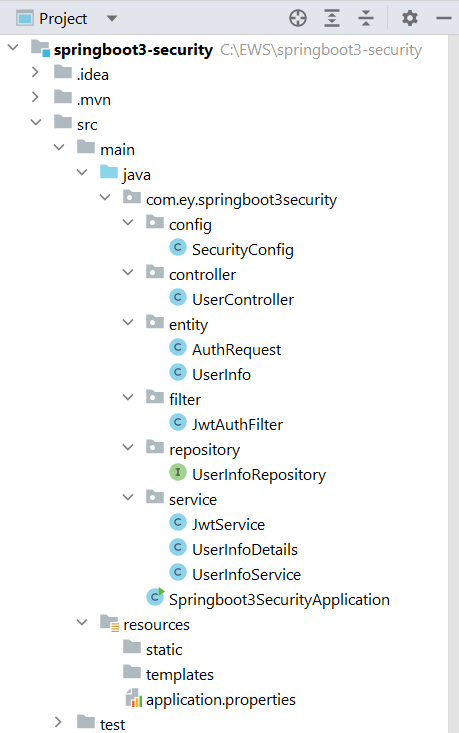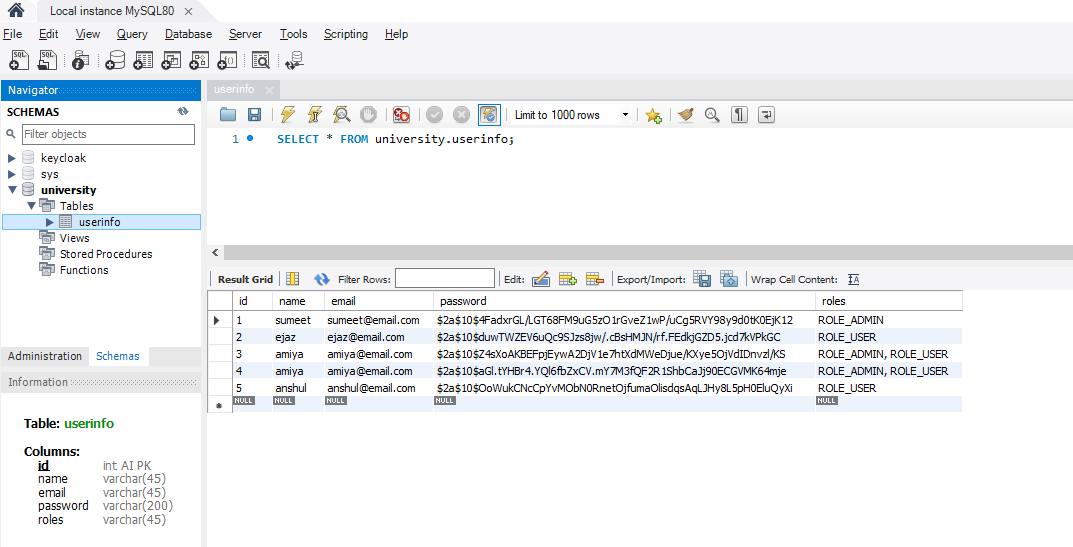Spring Boot 3.0 – JWT Authentication with Spring Security using MySQL Database
Last Updated :
16 Apr, 2024
In Spring Security 5.7.0, the spring team deprecated the WebSecurityConfigurerAdapter, as they encourage users to move towards a component-based security configuration. Spring Boot 3.0 has come with many changes inSpring Security . In this article, we’ll learn how to implement JWT authentication and authorization in a Spring Boot 3.0 application using Spring Security 6 with MySQL Database.
Demo Project
Step 1: Create a New Spring Boot Project in Spring Initializr
To create a new Spring Boot project, please refer to How to Create a Spring Boot Project in Spring Initializr and Run it in IntelliJ IDEA. For this project choose the following things
- Project: Maven
- Language: Java
- Packaging: Jar
- Java: 17
Please choose the following dependencies while creating the project.
- Spring Web
- Spring Security
- MySQL Driver
- Spring Data JPA
- Lombok
Additionally, we have added dependencies for JWT also. Below are the dependencies
<dependency>
<groupId>io.jsonwebtoken</groupId>
<artifactId>jjwt-api</artifactId>
<version>0.11.5</version>
</dependency>
<dependency>
<groupId>io.jsonwebtoken</groupId>
<artifactId>jjwt-impl</artifactId>
<version>0.11.5</version>
</dependency>
<dependency>
<groupId>io.jsonwebtoken</groupId>
<artifactId>jjwt-jackson</artifactId>
<version>0.11.5</version>
</dependency>
Below is the complete pom.xml file. Please cross-verify if you have missed some dependencies
XML
<?xml version="1.0" encoding="UTF-8"?>
<project xmlns="http://maven.apache.org/POM/4.0.0" xmlns:xsi="http://www.w3.org/2001/XMLSchema-instance"
xsi:schemaLocation="http://maven.apache.org/POM/4.0.0 https://maven.apache.org/xsd/maven-4.0.0.xsd">
<modelVersion>4.0.0</modelVersion>
<parent>
<groupId>org.springframework.boot</groupId>
<artifactId>spring-boot-starter-parent</artifactId>
<version>3.0.8</version>
<relativePath/> <!-- lookup parent from repository -->
</parent>
<groupId>com.gfg</groupId>
<artifactId>springboot3-security</artifactId>
<version>0.0.1-SNAPSHOT</version>
<name>springboot3-security</name>
<description>Demo project for Spring Boot 3 Security</description>
<properties>
<java.version>17</java.version>
</properties>
<dependencies>
<dependency>
<groupId>org.springframework.boot</groupId>
<artifactId>spring-boot-starter-data-jpa</artifactId>
</dependency>
<dependency>
<groupId>org.springframework.boot</groupId>
<artifactId>spring-boot-starter-security</artifactId>
</dependency>
<dependency>
<groupId>org.springframework.boot</groupId>
<artifactId>spring-boot-starter-web</artifactId>
</dependency>
<dependency>
<groupId>com.mysql</groupId>
<artifactId>mysql-connector-j</artifactId>
<scope>runtime</scope>
</dependency>
<dependency>
<groupId>org.projectlombok</groupId>
<artifactId>lombok</artifactId>
<optional>true</optional>
</dependency>
<dependency>
<groupId>org.springframework.boot</groupId>
<artifactId>spring-boot-starter-test</artifactId>
<scope>test</scope>
</dependency>
<dependency>
<groupId>org.springframework.security</groupId>
<artifactId>spring-security-test</artifactId>
<scope>test</scope>
</dependency>
<dependency>
<groupId>io.jsonwebtoken</groupId>
<artifactId>jjwt-api</artifactId>
<version>0.11.5</version>
</dependency>
<dependency>
<groupId>io.jsonwebtoken</groupId>
<artifactId>jjwt-impl</artifactId>
<version>0.11.5</version>
</dependency>
<dependency>
<groupId>io.jsonwebtoken</groupId>
<artifactId>jjwt-jackson</artifactId>
<version>0.11.5</version>
</dependency>
</dependencies>
<build>
<plugins>
<plugin>
<groupId>org.springframework.boot</groupId>
<artifactId>spring-boot-maven-plugin</artifactId>
<configuration>
<excludes>
<exclude>
<groupId>org.projectlombok</groupId>
<artifactId>lombok</artifactId>
</exclude>
</excludes>
</configuration>
</plugin>
</plugins>
</build>
</project>
Before moving to the project here is the complete project structure.

Step 2: Create a UserController
Go to the src > main > java > controller and create a class UserController and put the below code. In this, we have created a simple REST API in our controller class.
Java
import com.ey.springboot3security.entity.AuthRequest;
import com.ey.springboot3security.entity.UserInfo;
import com.ey.springboot3security.service.JwtService;
import com.ey.springboot3security.service.UserInfoService;
import org.springframework.beans.factory.annotation.Autowired;
import org.springframework.security.access.prepost.PreAuthorize;
import org.springframework.security.authentication.AuthenticationManager;
import org.springframework.security.authentication.UsernamePasswordAuthenticationToken;
import org.springframework.security.core.Authentication;
import org.springframework.security.core.userdetails.UsernameNotFoundException;
import org.springframework.web.bind.annotation.*;
@RestController
@RequestMapping("/auth")
public class UserController {
@Autowired
private UserInfoService service;
@Autowired
private JwtService jwtService;
@Autowired
private AuthenticationManager authenticationManager;
@GetMapping("/welcome")
public String welcome() {
return "Welcome this endpoint is not secure";
}
@PostMapping("/addNewUser")
public String addNewUser(@RequestBody UserInfo userInfo) {
return service.addUser(userInfo);
}
@GetMapping("/user/userProfile")
@PreAuthorize("hasAuthority('ROLE_USER')")
public String userProfile() {
return "Welcome to User Profile";
}
@GetMapping("/admin/adminProfile")
@PreAuthorize("hasAuthority('ROLE_ADMIN')")
public String adminProfile() {
return "Welcome to Admin Profile";
}
@PostMapping("/generateToken")
public String authenticateAndGetToken(@RequestBody AuthRequest authRequest) {
Authentication authentication = authenticationManager.authenticate(new UsernamePasswordAuthenticationToken(authRequest.getUsername(), authRequest.getPassword()));
if (authentication.isAuthenticated()) {
return jwtService.generateToken(authRequest.getUsername());
} else {
throw new UsernameNotFoundException("invalid user request !");
}
}
}
Step 3: Create a SecurityConfig Class
Go to the src > main > java > config and create a class SecurityConfig and put the below code. This is the new changes brought in Spring Boot 3.0.
Java
import com.ey.springboot3security.filter.JwtAuthFilter;
import com.ey.springboot3security.service.UserInfoService;
import org.springframework.beans.factory.annotation.Autowired;
import org.springframework.context.annotation.Bean;
import org.springframework.context.annotation.Configuration;
import org.springframework.security.authentication.AuthenticationManager;
import org.springframework.security.authentication.AuthenticationProvider;
import org.springframework.security.authentication.dao.DaoAuthenticationProvider;
import org.springframework.security.config.annotation.authentication.configuration.AuthenticationConfiguration;
import org.springframework.security.config.annotation.method.configuration.EnableMethodSecurity;
import org.springframework.security.config.annotation.web.builders.HttpSecurity;
import org.springframework.security.config.annotation.web.configuration.EnableWebSecurity;
import org.springframework.security.config.http.SessionCreationPolicy;
import org.springframework.security.core.userdetails.UserDetailsService;
import org.springframework.security.crypto.bcrypt.BCryptPasswordEncoder;
import org.springframework.security.crypto.password.PasswordEncoder;
import org.springframework.security.web.SecurityFilterChain;
import org.springframework.security.web.authentication.UsernamePasswordAuthenticationFilter;
@Configuration
@EnableWebSecurity
@EnableMethodSecurity
public class SecurityConfig {
@Autowired
private JwtAuthFilter authFilter;
// User Creation
@Bean
public UserDetailsService userDetailsService() {
return new UserInfoService();
}
// Configuring HttpSecurity
@Bean
public SecurityFilterChain securityFilterChain(HttpSecurity http) throws Exception {
return http.csrf(csrf -> csrf.disable())
.authorizeHttpRequests(auth -> auth.requestMatchers("/auth/welcome", "/auth/addNewUser", "/auth/generateToken").permitAll())
.authorizeHttpRequests(auth -> auth.requestMatchers("/auth/user/**").authenticated())
.authorizeHttpRequests(auth -> auth.requestMatchers("/auth/admin/**").authenticated())
.sessionManagement(sess -> sess.sessionCreationPolicy(SessionCreationPolicy.STATELESS))
.authenticationProvider(authenticationProvider())
.addFilterBefore(authFilter, UsernamePasswordAuthenticationFilter.class)
.build();
}
// Password Encoding
@Bean
public PasswordEncoder passwordEncoder() {
return new BCryptPasswordEncoder();
}
@Bean
public AuthenticationProvider authenticationProvider() {
DaoAuthenticationProvider authenticationProvider = new DaoAuthenticationProvider();
authenticationProvider.setUserDetailsService(userDetailsService());
authenticationProvider.setPasswordEncoder(passwordEncoder());
return authenticationProvider;
}
@Bean
public AuthenticationManager authenticationManager(AuthenticationConfiguration config) throws Exception {
return config.getAuthenticationManager();
}
}
Step 4: Create Entity Classes
Go to the src > main > java > entity and create a class UserInfo and put the below code.
Java
import jakarta.persistence.Entity;
import jakarta.persistence.GeneratedValue;
import jakarta.persistence.GenerationType;
import jakarta.persistence.Id;
import lombok.AllArgsConstructor;
import lombok.Data;
import lombok.NoArgsConstructor;
@Entity
@Data
@AllArgsConstructor
@NoArgsConstructor
public class UserInfo {
@Id
@GeneratedValue(strategy = GenerationType.IDENTITY)
private int id;
private String name;
private String email;
private String password;
private String roles;
}
Similarly, create a class AuthRequest and put the below code.
Java
import lombok.AllArgsConstructor;
import lombok.Data;
import lombok.NoArgsConstructor;
@Data
@AllArgsConstructor
@NoArgsConstructor
public class AuthRequest {
private String username;
private String password;
}
Step 5: Create Filter Class
Go to the src > main > java > filter and create a class JwtAuthFilter and put the below code.
Java
import com.ey.springboot3security.service.JwtService;
import com.ey.springboot3security.service.UserInfoService;
import jakarta.servlet.FilterChain;
import jakarta.servlet.ServletException;
import jakarta.servlet.http.HttpServletRequest;
import jakarta.servlet.http.HttpServletResponse;
import org.springframework.beans.factory.annotation.Autowired;
import org.springframework.security.authentication.UsernamePasswordAuthenticationToken;
import org.springframework.security.core.context.SecurityContextHolder;
import org.springframework.security.core.userdetails.UserDetails;
import org.springframework.security.web.authentication.WebAuthenticationDetailsSource;
import org.springframework.stereotype.Component;
import org.springframework.web.filter.OncePerRequestFilter;
import java.io.IOException;
// This class helps us to validate the generated jwt token
@Component
public class JwtAuthFilter extends OncePerRequestFilter {
@Autowired
private JwtService jwtService;
@Autowired
private UserInfoService userDetailsService;
@Override
protected void doFilterInternal(HttpServletRequest request, HttpServletResponse response, FilterChain filterChain) throws ServletException, IOException {
String authHeader = request.getHeader("Authorization");
String token = null;
String username = null;
if (authHeader != null && authHeader.startsWith("Bearer ")) {
token = authHeader.substring(7);
username = jwtService.extractUsername(token);
}
if (username != null && SecurityContextHolder.getContext().getAuthentication() == null) {
UserDetails userDetails = userDetailsService.loadUserByUsername(username);
if (jwtService.validateToken(token, userDetails)) {
UsernamePasswordAuthenticationToken authToken = new UsernamePasswordAuthenticationToken(userDetails, null, userDetails.getAuthorities());
authToken.setDetails(new WebAuthenticationDetailsSource().buildDetails(request));
SecurityContextHolder.getContext().setAuthentication(authToken);
}
}
filterChain.doFilter(request, response);
}
}
Step 6: Create a Repository Interface
Go to the src > main > java > repository and create an interface UserInfoRepository and put the below code.
Java
import com.ey.springboot3security.entity.UserInfo;
import org.springframework.data.jpa.repository.JpaRepository;
import org.springframework.stereotype.Repository;
import java.util.Optional;
@Repository
public interface UserInfoRepository extends JpaRepository<UserInfo, Integer> {
Optional<UserInfo> findByName(String username);
}
Step 7: Create Service Classes
Go to the src > main > java > service and create a class JwtService and put the below code.
Java
import io.jsonwebtoken.Claims;
import io.jsonwebtoken.Jwts;
import io.jsonwebtoken.SignatureAlgorithm;
import io.jsonwebtoken.io.Decoders;
import io.jsonwebtoken.security.Keys;
import org.springframework.security.core.userdetails.UserDetails;
import org.springframework.stereotype.Component;
import java.security.Key;
import java.util.Date;
import java.util.HashMap;
import java.util.Map;
import java.util.function.Function;
@Component
public class JwtService {
public static final String SECRET = "5367566B59703373367639792F423F4528482B4D6251655468576D5A71347437";
public String generateToken(String userName) {
Map<String, Object> claims = new HashMap<>();
return createToken(claims, userName);
}
private String createToken(Map<String, Object> claims, String userName) {
return Jwts.builder()
.setClaims(claims)
.setSubject(userName)
.setIssuedAt(new Date(System.currentTimeMillis()))
.setExpiration(new Date(System.currentTimeMillis() + 1000 * 60 * 30))
.signWith(getSignKey(), SignatureAlgorithm.HS256).compact();
}
private Key getSignKey() {
byte[] keyBytes= Decoders.BASE64.decode(SECRET);
return Keys.hmacShaKeyFor(keyBytes);
}
public String extractUsername(String token) {
return extractClaim(token, Claims::getSubject);
}
public Date extractExpiration(String token) {
return extractClaim(token, Claims::getExpiration);
}
public <T> T extractClaim(String token, Function<Claims, T> claimsResolver) {
final Claims claims = extractAllClaims(token);
return claimsResolver.apply(claims);
}
private Claims extractAllClaims(String token) {
return Jwts
.parserBuilder()
.setSigningKey(getSignKey())
.build()
.parseClaimsJws(token)
.getBody();
}
private Boolean isTokenExpired(String token) {
return extractExpiration(token).before(new Date());
}
public Boolean validateToken(String token, UserDetails userDetails) {
final String username = extractUsername(token);
return (username.equals(userDetails.getUsername()) && !isTokenExpired(token));
}
}
Similarly, create a class UserInfoDetails and put the below code.
Java
import com.ey.springboot3security.entity.UserInfo;
import org.springframework.security.core.GrantedAuthority;
import org.springframework.security.core.authority.SimpleGrantedAuthority;
import org.springframework.security.core.userdetails.UserDetails;
import java.util.Arrays;
import java.util.Collection;
import java.util.List;
import java.util.stream.Collectors;
public class UserInfoDetails implements UserDetails {
private String name;
private String password;
private List<GrantedAuthority> authorities;
public UserInfoDetails(UserInfo userInfo) {
name = userInfo.getName();
password = userInfo.getPassword();
authorities = Arrays.stream(userInfo.getRoles().split(","))
.map(SimpleGrantedAuthority::new)
.collect(Collectors.toList());
}
@Override
public Collection<? extends GrantedAuthority> getAuthorities() {
return authorities;
}
@Override
public String getPassword() {
return password;
}
@Override
public String getUsername() {
return name;
}
@Override
public boolean isAccountNonExpired() {
return true;
}
@Override
public boolean isAccountNonLocked() {
return true;
}
@Override
public boolean isCredentialsNonExpired() {
return true;
}
@Override
public boolean isEnabled() {
return true;
}
}
Similarly, create a class UserInfoService and put the below code.
Java
import com.ey.springboot3security.entity.UserInfo;
import com.ey.springboot3security.repository.UserInfoRepository;
import org.springframework.beans.factory.annotation.Autowired;
import org.springframework.security.core.userdetails.UserDetails;
import org.springframework.security.core.userdetails.UserDetailsService;
import org.springframework.security.core.userdetails.UsernameNotFoundException;
import org.springframework.security.crypto.password.PasswordEncoder;
import org.springframework.stereotype.Service;
import java.util.Optional;
@Service
public class UserInfoService implements UserDetailsService {
@Autowired
private UserInfoRepository repository;
@Autowired
private PasswordEncoder encoder;
@Override
public UserDetails loadUserByUsername(String username) throws UsernameNotFoundException {
Optional<UserInfo> userDetail = repository.findByName(username);
// Converting userDetail to UserDetails
return userDetail.map(UserInfoDetails::new)
.orElseThrow(() -> new UsernameNotFoundException("User not found " + username));
}
public String addUser(UserInfo userInfo) {
userInfo.setPassword(encoder.encode(userInfo.getPassword()));
repository.save(userInfo);
return "User Added Successfully";
}
}
Step 8: Make the following changes in the application.properties file
spring.main.allow-circular-references=true
spring.datasource.driver-class-name=com.mysql.cj.jdbc.Driver
spring.datasource.url = jdbc:mysql://localhost:3306/university
spring.datasource.username = root
spring.datasource.password = 143@Arpilu
spring.jpa.hibernate.ddl-auto = update
spring.jpa.properties.hibernate.dialect = org.hibernate.dialect.MySQLDialect
spring.jpa.hibernate.naming.physical-strategy=org.hibernate.boot.model.naming.PhysicalNamingStrategyStandardImpl
Test the Application
Now run your application and test it out. Hit the following URL
http://localhost:8080/auth/addNewUser
It will add the user to the database.

Below is our database screenshot.

Now, hit the following URL to generate the token.
http://localhost:8080/auth/generateToken
It will generate the token.

Now using this take we can access our endpoint according to the ROLE. Hit the following URL and put the Bearer token.
http://localhost:8080/auth/user/userProfile
Refer to the screenshot below.

Share your thoughts in the comments
Please Login to comment...